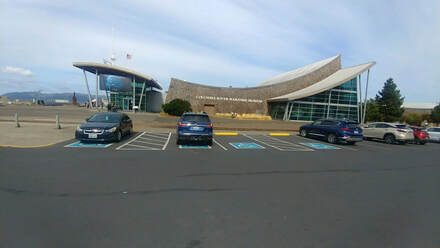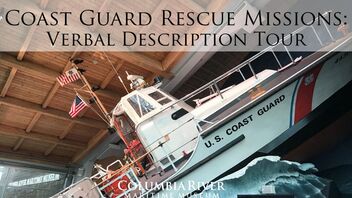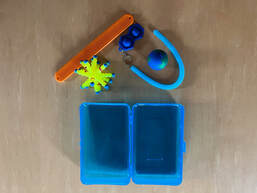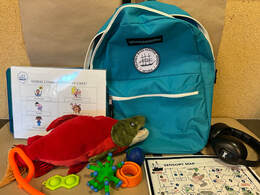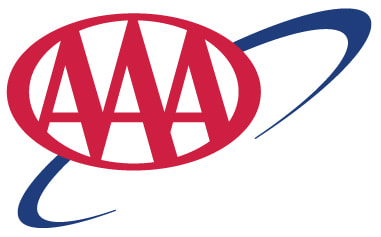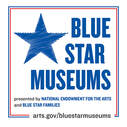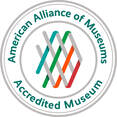The Columbia River Maritime Museum is committed to making
its collections, buildings, programs and services accessible to all visitors.
Please email [email protected] for accessibility questions or assistance.
JOIN US FOR SENSORY SUNDAY!
No Registration Required, Standard Admission Rates Apply
SENSORY SUNDAY SCHOLARSHIPS ARE NOW AVAILABLE! CONTACT US!
Phone 503-325-2323, Text 503-741-7056, Email to [email protected]
All are welcome!
SENSORY SUNDAY SCHOLARSHIPS ARE NOW AVAILABLE! CONTACT US!
Phone 503-325-2323, Text 503-741-7056, Email to [email protected]
All are welcome!
ADMISSION ACCESS
Museums for All - General Admission Discount
As a participant in the Museums for All program, the Museum offers reduced admission for all visitors with an EBT or WIC card.
Bring your EBT or WIC card and matching I.D. to receive $3.00 admission tickets for up to 4 people from the same household.
Discount applies to Adult, Senior and Child general admission. Discount does not apply to 3D theater tickets.
Cardholder must be present at time of admission.
Museums for All Discounted CREW/FAMILY Membership
Beginning July 1, 2024, the Museums for All Admission initiative is extended to our membership program. Individuals receiving food assistance (EBT/WIC) will receive the benefits of a CREW/FAMILY membership at the reduced rate of $38 by presenting their EBT/WIC card and matching photo ID at the Admissions Desk.
Museums for All Memberships must be purchased in-person to verify eligibility. Museums for All memberships are not eligible to be gifted and are not transferable.
No other discounts apply. Questions? Contact our Membership Assistant.
Blue Star Museums
Currently-serving military personnel and their families, including National Guard and Reserves, are free starting on Armed Forces Day in mid-May and ending on Labor Day in early September.
Museums for All - General Admission Discount
As a participant in the Museums for All program, the Museum offers reduced admission for all visitors with an EBT or WIC card.
Bring your EBT or WIC card and matching I.D. to receive $3.00 admission tickets for up to 4 people from the same household.
Discount applies to Adult, Senior and Child general admission. Discount does not apply to 3D theater tickets.
Cardholder must be present at time of admission.
Museums for All Discounted CREW/FAMILY Membership
Beginning July 1, 2024, the Museums for All Admission initiative is extended to our membership program. Individuals receiving food assistance (EBT/WIC) will receive the benefits of a CREW/FAMILY membership at the reduced rate of $38 by presenting their EBT/WIC card and matching photo ID at the Admissions Desk.
Museums for All Memberships must be purchased in-person to verify eligibility. Museums for All memberships are not eligible to be gifted and are not transferable.
No other discounts apply. Questions? Contact our Membership Assistant.
Blue Star Museums
Currently-serving military personnel and their families, including National Guard and Reserves, are free starting on Armed Forces Day in mid-May and ending on Labor Day in early September.
Library Memberships
Regional libraries are provided with free memberships for check-out by their patrons. Each library is provided with two membership cards, each card offering admission to the Museum, Lightship 'Columbia', 3D theater, and a 10% discount in the Museum Store.
22 libraries in northwest Oregon and southwest Washington that are included in this program:
Regional libraries are provided with free memberships for check-out by their patrons. Each library is provided with two membership cards, each card offering admission to the Museum, Lightship 'Columbia', 3D theater, and a 10% discount in the Museum Store.
22 libraries in northwest Oregon and southwest Washington that are included in this program:
|
NORTHWEST OREGON:
Astoria Public Library, 450 10th Street, Astoria Warrenton Community Library, 160 S. Main Avenue, Warrenton Clatsop Community College Dora Badollet Library, 1680 Lexington Avenue, Astoria Seaside Public Library, 1131 Broadway Street, Seaside Clatskanie Library, 11 Lillich Street, Clatskanie Scappoose Public Library, 52469 SE 2nd Street, Scappoose Tillamook County Libraries: Bay City Branch, 5525 B Street (Community Hall), Bay City Bookmobile, mobile library services Garibaldi Branch, 107 6th Street (City Hall), Garibaldi Manzanita Branch, 571 Laneda, Manzanita Rockaway Beach Branch, 120 N. Coral, Rockaway Beach South Tillamook County Branch, 6200 Camp Street, Pacific City Tillamook Branch, 1716 Third Street, Tillamook |
SOUTHWEST WASHINGTON:
Longview Public Library, 1600 Louisiana Street, Longview Kelso Public Library, 351 Three Rivers Drive #1263, Kelso Kalama Public Library, 312 N. First Street, Kalama Ilwaco Timberland Library, 158 First Avenue N, Ilwaco Naselle Timberland Library, 4 Parpala Road, Naselle Ocean Park Timberland Library, 1308 256th Lane, Ocean Park Raymond Timberland Library, 507 Duryea Street, Raymond South Bend Timberland Library, 1214 W 1st Street. South Bend TRL Anywhere Program, mobile library services |
PARKING, ENTRANCE & INSIDE THE MUSEUM
There are four (4) accessible parking spaces available outside the main Museum entrance. Visitors may be dropped off and picked up at the loading area in front of the main entrance. The barrier free entrance is located at the south Museum entry door.
There are four (4) accessible parking spaces available outside the main Museum entrance. Visitors may be dropped off and picked up at the loading area in front of the main entrance. The barrier free entrance is located at the south Museum entry door.
SERVICE ANIMAL POLICY
The Columbia River Maritime Museum is committed to welcoming a wide and diverse audience, including those assisted by trained service animals.
The Columbia River Maritime Museum complies with the Americans with Disabilities act (ADA), which defines service animals as a dog that has been individually trained to do work or perform tasks for an individual with a disability. The task(s) performed by the dog must be directly related to the person’s disability. The Columbia River Maritime Museum allows service dogs in all public areas of the Museum.
The Columbia River Maritime Museum does not allow Emotional Support Animals (ESA) inside the Museum. Emotional Support Animals, Comfort Animals, or Therapy Animals which provide comfort do not qualify as service animals under the ADA.
The following questions will be asked of each guest with a service dog:
If the dog is out of control or not housebroken, the handler will be asked to remove the dog from the Museum.
The Columbia River Maritime Museum is committed to welcoming a wide and diverse audience, including those assisted by trained service animals.
The Columbia River Maritime Museum complies with the Americans with Disabilities act (ADA), which defines service animals as a dog that has been individually trained to do work or perform tasks for an individual with a disability. The task(s) performed by the dog must be directly related to the person’s disability. The Columbia River Maritime Museum allows service dogs in all public areas of the Museum.
The Columbia River Maritime Museum does not allow Emotional Support Animals (ESA) inside the Museum. Emotional Support Animals, Comfort Animals, or Therapy Animals which provide comfort do not qualify as service animals under the ADA.
The following questions will be asked of each guest with a service dog:
- Is the service dog required because of a disability?
- What work or task has the dog been trained to perform?
If the dog is out of control or not housebroken, the handler will be asked to remove the dog from the Museum.
MOBILITY DEVICES
A limited number of wheelchairs and rollators (rolling walkers) are available free of charge from the Admissions Desk
on a first come, first serve basis.
All galleries and the 3D theater are wheelchair accessible. The Lightship Columbia is not wheelchair accessible.
Wheelchairs, including manual or electric single seat chairs and electric mobility seated scooters, and other manually operated mobility devices including walkers, crutches, canes, braces and other similar devices, are permitted in all public areas of the Museum.
No other type of manually operated or power-driven devices are permitted in the Museum, including but not limited to Segways, self-balancing two-wheel electric scooters or "hoverboards", wagons, tricycles and carts. These devices are not permitted due to the high volume of pedestrian traffic in the Museum, the size, type, weight, dimensions and speed of these devices, and the substantial risk of harm to Museum exhibits, other visitors and the user.
A limited number of wheelchairs and rollators (rolling walkers) are available free of charge from the Admissions Desk
on a first come, first serve basis.
All galleries and the 3D theater are wheelchair accessible. The Lightship Columbia is not wheelchair accessible.
Wheelchairs, including manual or electric single seat chairs and electric mobility seated scooters, and other manually operated mobility devices including walkers, crutches, canes, braces and other similar devices, are permitted in all public areas of the Museum.
No other type of manually operated or power-driven devices are permitted in the Museum, including but not limited to Segways, self-balancing two-wheel electric scooters or "hoverboards", wagons, tricycles and carts. These devices are not permitted due to the high volume of pedestrian traffic in the Museum, the size, type, weight, dimensions and speed of these devices, and the substantial risk of harm to Museum exhibits, other visitors and the user.
EXHIBIT VIDEO SUBTITLES
Subtitles for video displays are now available in four of the Museum's galleries:
Carronade Video in U.S.S. Shark Gallery
"Mapping the Coast" Video in the Mapping/Navigation Gallery
Peacock Video in the Crossing the Bar Gallery
"The Great River of the West" in the Science of Storms Gallery
New Carissa Video in Shipwrecks! Gallery
Subtitles for video displays are now available in four of the Museum's galleries:
Carronade Video in U.S.S. Shark Gallery
"Mapping the Coast" Video in the Mapping/Navigation Gallery
Peacock Video in the Crossing the Bar Gallery
"The Great River of the West" in the Science of Storms Gallery
New Carissa Video in Shipwrecks! Gallery
MAGNIFIERS
Disposable handheld magnifiers, with 6x clear magnification, for use in the galleries are available upon request at the Admissions Desk. Visitors may keep the disposable magnifiers.
Disposable handheld magnifiers, with 6x clear magnification, for use in the galleries are available upon request at the Admissions Desk. Visitors may keep the disposable magnifiers.
COLOR BLINDNESS CORRECTING GLASSES
One (1) pair of Adult, Indoor ENCHROMA color blindness correcting glasses are available for check out at the Admissions Desk.
One (1) pair of Adult, Indoor ENCHROMA color blindness correcting glasses are available for check out at the Admissions Desk.
INDIVIDUAL SELF-GUIDED AUDIO & TACTILE TOUR
Your tour will highlight a map of the Lower Columbia region, a torpedo from Astoria's World War II history, and a towboat's wheelhouse in the Brix Maritime Hall. A limited number of iPods and earbuds are available for free check-out using an I.D. at the Admissions Desk. Visitors are encouraged to bring their own earbuds if they wish.
Your tour will highlight a map of the Lower Columbia region, a torpedo from Astoria's World War II history, and a towboat's wheelhouse in the Brix Maritime Hall. A limited number of iPods and earbuds are available for free check-out using an I.D. at the Admissions Desk. Visitors are encouraged to bring their own earbuds if they wish.
VIRTUAL VERBAL DESCRIPTION TOUR
Columbia River Maritime Museum offers a virtual Verbal Description Tour for visitors who are looking for a more detailed description of the museum’s space. During this online presentation, we will introduce visitors to the museum and dive deep into the Coast Guard’s life-saving work on the coast with our exhibit, Coast Guard Rescue Missions.
Verbal Description Tours are available to all and can be particularly useful for those who are blind/low vision or have sensory sensitivities. Registration for this hour-long program is free.
Contact [email protected] for more information
VISIT GUIDES
VISIT GUIDES
Our downloadable Social Narrative provides a printable guide that lets you create a preview of the Museum experience for guests who are more comfortable knowing what to expect.
A limited number of Sensory Backpacks are available for free check-out using an I.D. at the Admissions Desk.
A limited number of noise-reducing headphones are available for free check-out using an I.D. at the Admissions Desk.
Additional Audio, Visual, Tactile and Olfactory information about the exhibits - CLICK HERE






